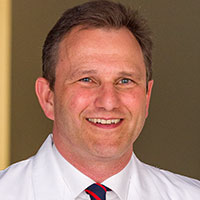New Patient Appointment or 214-645-8300

Gerald Greil, M.D., Ph.D. Answers Questions On: Congenital Heart Disease
-
What recent advances in pediatric cardiology have had the most impact on the treatment of children with congenital heart disease?
-
Novel, noninvasive, diagnostic technologies are among the most transformative. They are patient-friendly, posing zero risk to the child while providing extremely high sensitivity and accuracy regarding the patient’s diagnosis and allowing us to avoid many of the more invasive procedures we used in the past.
We combine these imaging technologies with invasive procedures when needed. For example, we may perform catheterization with surgery or with MRI (magnetic resonance imaging), or we use 3-D MRI or computed tomography (CT) images to precisely guide complex cardiac procedures in congenital heart disease. This way, we minimize the invasiveness of each treatment as much as we can. It is much safer for the child, and it improves patient outcomes.
We now also evaluate technologies that allow us to monitor how young patients with complex heart disease are doing at home between necessary surgical procedures. If there is a concern, the computer receiving the data could quickly inform physicians, who will then follow up. At UT Southwestern, these monitoring services will be integrated into our Safe at Home program, which provides round-the-clock support and coordinated care from pediatric cardiologists, nurse practitioners, social workers, nutritionists, and pediatricians. This, too, has significantly improved outcomes for complex patients with only one main cardiac chamber, so called hypoplastic left heart syndrome (HLHS).
-
What steps should families be prepared to take if congenital heart disease is diagnosed before their baby is even born?
-
These days, it is not at all unusual for congenital heart disease to be diagnosed in utero. Many cardiac defects can be picked up by prenatal ultrasound very early during pregnancy.
Should a problem be identified during a routine Ob/Gyn visit, we follow up with specialized prenatal cardiac imaging. We can get a pretty clear picture of a child's heart and determine whether it is a major or minor problem with high accuracy. Parents are with us while we are doing the imaging, so they can follow the exam.
The diagnosis, in turn, affects the next steps. If the problem is uncomplicated and will require a straightforward repair, the baby can be delivered where the family wants, stabilized after birth with medication or minimally invasive procedures, then referred to us for treatment.
However, if the baby’s condition is more complex, we recommend that the mother deliver her baby near our Children’s Medical Center so that the baby can be brought to the pediatric cardiology unit immediately after birth. After all, the mom is not the patient – the baby is. So if a complex condition has been identified before delivery, the baby should be born as close as possible to where expert treatment can be provided.
-
What is the outlook for a child with congenital heart disease? What types of activities can children with these conditions do as they grow up?
-
Most children with congenital heart disease will have normal, or close to normal, lives. If they had a straightforward heart defect that was repaired surgically or with a minimal invasive procedure in the cardiac catheterization laboratory, their condition has been cured. Typically, they need to be seen only two or three times after the procedure and then will not require any further contact with pediatric cardiologists.
However, some patients with more complex heart conditions will need lifelong surveillance. For these youngsters, our center provides everything needed to facilitate this long-term follow-up.
As patients grow up, we bring in colleagues specializing in adult cardiology, whose physicians are specifically trained to care for adults with congenital heart disease. These caregivers will take over the medical monitoring of these adult patients and will provide them with support on a regular basis over the course of their lives. If there are some restrictions to the activities that patients can engage in, our team will work diligently to make sure that they have the best quality of life possible.